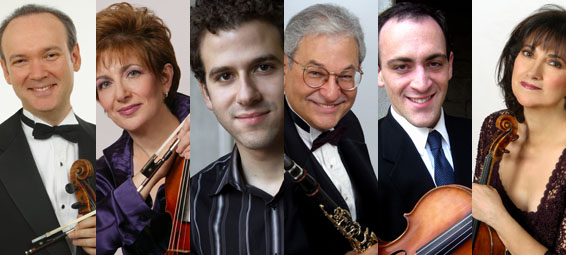I felt a pang of apprehension late Monday afternoon as I left Denton and drove toward Dallas for the opening subscription concert of Dallas Chamber Music, an organization dedicated to presenting an annual season of guest ensembles. Mozart, Mendelssohn, and Brahms don’t normally strike fear into concertgoers, of course, and there’s hardly a more reliable musical organization than the evening’s attraction, the Chamber Music Society of Lincoln Center, which aptly describes itself as the musical equivalent of a “repertory company,” constantly shaping and re-shaping ad hoc ensembles from the ranks of thirty-five of the world’s leading musicians.
But somehow, on paper, the program gave off the odor of small town museum neatness: an orderly, chronological journey through three unavoidable heroes from the standard list of great composers, presented by safe representatives of the New York musical establishment, to be consumed by an audience of well-behaved middle-of-America WASPS and near-WASPS on the campus of Southern Methodist University. The newest work on the program was a 120 years old. Except for the presence of electrical lighting and the absence of bustles on the ladies, one might as well have been attending a concert in 1895 instead of 2010.
I’ll maintain a little bit of reservation toward the inherent anachronism of a concert totally devoted to an all-German, pre-modern agenda, but admit that the evening was anything but stodgy. Mozart was at the top of his game when he wrote the Quintet in E-flat for two violins, two violas, and cello in 1791, and, for this performance, so was the evening’s ensemble, made up of violinists Ani Kavafian and Ida Kavafian, violists Mark Holloway and Paul Neubauer, and cellist Nicholas Canellakis. From the moody, operatic opening of the first movement to the spirited Finale (pushed forward from the indicated Allegro to a genuine Presto), everything was in place.
Mendelssohn’s Quintet in A, created when the composer was a teenager and revised by him at the ripe old age of 23, exuded, in this performance, the amazing command of structure and instrumental timbre that can still surprise the attentive listener. While Mozart was largely content with pure, straightforward sound from a small chamber ensemble, Mendelssohn clearly aimed at—and succeeded in—discovering an almost choral resonance, beautifully realized by these musicians. Mendelssohn’s reputation declined slowly in the first century and a quarter after his death—during my youth, he had definitely fallen into the category of musical has-beens—but audiences and performers have, in recent decades, found a new appeal in a music that constantly proclaims serenity in opposition to a chaotic world.
Clarinetist David Shifrin joined the strings (minus violist Holloway) after intermission for Brahms’ autumnal Quintet in B minor. Shifrin’s always gorgeous but constantly varied tone, not unlike that of a great singer, provided the focal point of a wonderfully executed rendition of this dark, uncompromising monument of the chamber repertoire.
Photo: (from left) Paul Neubauer, Ida Kavafian, Nicholas Canellakis, David Shifrin, Mark Holloway, and Ani Kavafian (Courtesy of the Chamber Music Society of Lincoln Center).





